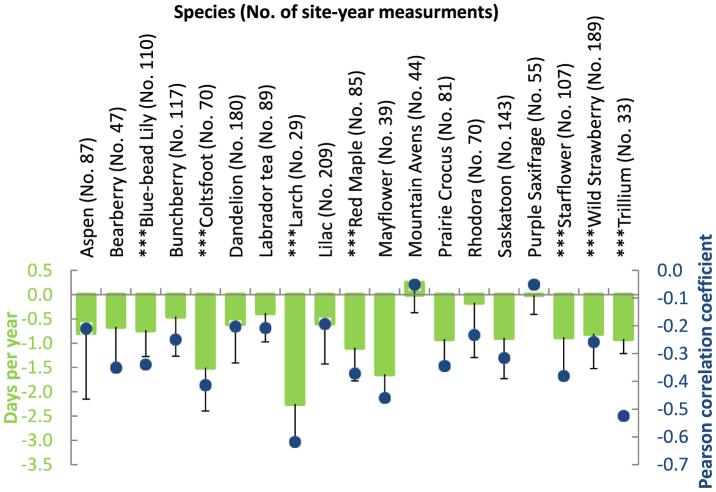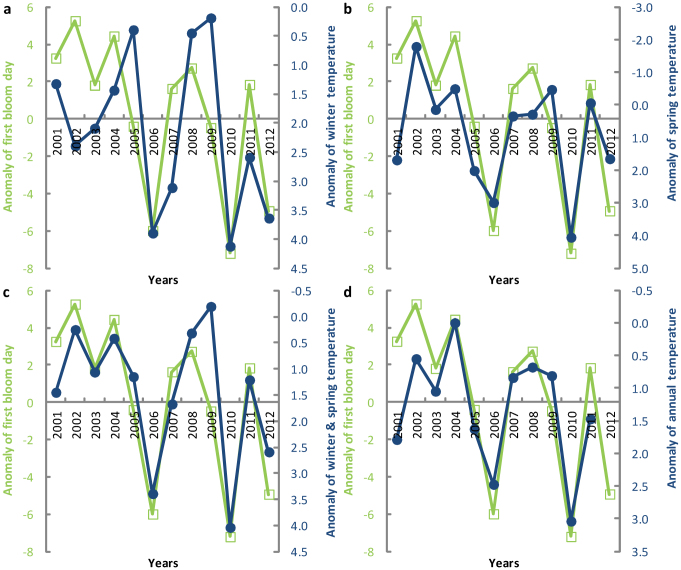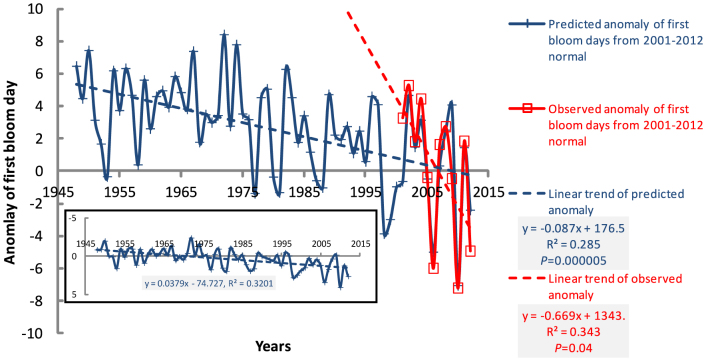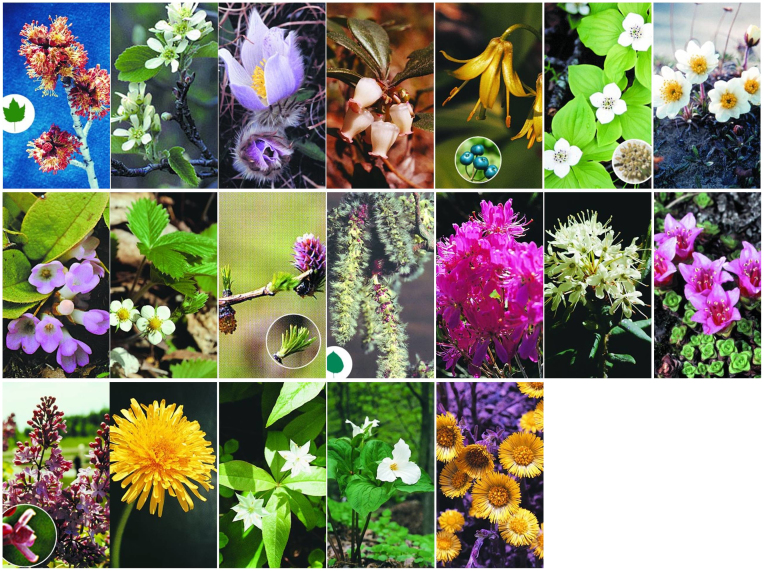Abstract
The timing of crucial events in plant life cycles is shifting in response to climate change. We use phenology records from PlantWatch Canada ‘Citizen Science’ networks to study recent rapid shifts of flowering phenology and its relationship with climate. The average first flower bloom day of 19 Canadian plant species has advanced by about 9 days during 2001–2012. 73% of the rapid and unprecedented first bloom day advances are explained by changes in mean annual national temperature, allowing the reconstruction of historic flower phenology records starting from 1948. The overall trends show that plant flowering in Canada is advancing by about 9 days per °C. This analysis reveals the strongest biological signal yet of climate warming in Canada. This finding has broad implications for niche differentiation among coexisting species, competitive interactions between species, and the asynchrony between plants and the organisms they interact with.
Plant phenological events such as bud burst, flowering, and senescence have received increased attention in the light of climate warming1,2,3,4,5. Even though changes in various plant phenological events have substantial consequences for ecosystem functioning, reproductive events such as flowering time largely determine population and community dynamics in future generations, affecting evolutionary processes. Flowering time also impacts animals for which pollen, nectar, and seeds are important resources, while earlier flowering also implies earlier activity in other processes and phenological events (leaf expansion, root growth, and nutrient uptake) that are indicators of environmental cues such as temperature, moisture, and photoperiod. The timing of spring flowering and leafing as well as terrestrial primary production of perennial plants is largely controlled by temperature across Canada6,7,8,9. ‘Citizen Science’ initiatives have recently been successful at publicizing phenology and encouraging public participation in recording. Examples of these are PlantWatch Canada networks (www.naturewatch.ca). Among several plant phenological events, first bloom defined as a plant stage at which the first flower buds have opened in an observed tree or shrub or in a patch of smaller plants, constitutes the most straightforward recording for scientific use. We have analyzed the first bloom day for a set of 19 plant species (see Supplementary Table S1 online for list of plant species and form) recorded by several observers across Canada between years 2001 and 2012 (see Supplementary Table S2 online for list of the measurement locations). We use first flower bloom day records from PlantWatch Canada10 ‘Citizen Science’ networks to study the flowering phenology trend and its relationship with climate.
In the present study, we have selected only the first bloom day records observed by at least five observers, at a minimum of five different locations in order to remove observer bias. The interannual variability expressed as an anomaly, and trend expressed as a regression slope are calculated for each site and species independently. The statistics of interannual variability and trend at species and national levels were calculated from the site-year measurement weighted averages of site level anomalies and slopes. Calculating interannual variability and trend at each site reduces possible biases due to errors in species naming, geographic position tagging, inter-observer bias, and the influences of variability in site productivity and latitudinal gradients on flowering phenology. Our approach, i.e., computing site level anomaly and trend statistics rather than directly averaging the first bloom day records across Canada, is a novel method for partially removing possible biases when the quality of data is unknown in ‘Citizen Science’ records.
Results
Our results suggest that on sample size (site-year measurements) weighted averages, flowering days are advanced by 0.732 days per year during 2001–2012 (Figure 1). 18 out of 19 species showed earlier first bloom days (Figure 1). 7 (37%) Canadian plant species show significantly earlier first bloom day anomalies (p < 0.05, Student's t-test) (Figure 1). Few species showed larger advances including Larch (Larix laricina), Coltsfoot (Tussilago farfara), and Mayflower (Epigaea repens). The two arctic and alpine plants, Mountain Avens (Dryas integrifolia) and Purple Saxifrage (Saxifraga oppositifolia) showed a delay or little change in first bloom days. Generally speaking, our analysis indicates that first bloom days of temperate and boreal flowering plants are advancing whereas arctic and alpine flowering plants show a delay or little change.
Figure 1. The measurement weighted average first bloom days per year for 19 plant species across Canada.
The first bloom days per year are calculated from linear regression slope (β) in the form of Y = α + βX. Y is first bloom day of a given year, α is regression intercept, β is regression slope, and X is a calendar year. The numbers (No.) correspond to the number of site-year measurements between years 2001 and 2012. The weighted average of Pearson correlation coefficient by the number of measurements per site is also given. The measurements from the Canadian ‘Citizen Science’ PlantWatch data for the given species observed by at least five observers, at a minimum of five different locations, with at least five year measurements between the years 2001 and 2012, totaling 1784 unique site-year measurements were included in the calculation. The weighted overall average slope by the number of measurements is -0.732 corresponding to average advance of flowering days per year. The flowering days advanced over Canada during the years 2001–2012 by -8.78 (weighted average by number of measurements). Error bars represent half standard error of the regression slopes. *** represents species with significantly earlier first bloom day anomalies (p < 0.05, Student's t-test).
During the sampling period excluding year 2012, Canada's annual temperature increased by 0.6°C from 1961–1990 average normal (www.ec.gc.ca). The entire sampling period had warmer annual temperatures than the normal years. Our results confirm that climate warming advances the first bloom days of early flowering species (Figures 1 and 2). The advances of first bloom days are significantly explained by changes in mean annual temperatures (R2 = 0.73, p = 0.0009). Figure 2 shows the statistically significant (R2 = 0.34, p = 0.04) Canada-wide first bloom day anomalies during 2001–2012. The combined winter (December, January, and February) and spring (March, April, and May) temperatures explain 71% of the changes of the first bloom days (Figure 2). When the winter and spring temperatures are used as independent regressors of estimate, they explain 75% changes in the first bloom days (Figure 3). Statistical analysis between the first bloom day and mean annual national temperature anomalies indicate that during 2001–2011, plant flowering in Canada advanced by about 9 days per °C. In an analysis from western Canada spanning 1936–19969, flowering events of Aspen (Populus tremuloides) advanced by 8 days in 60 years, a slower rate than we observed.
Figure 2. The relationship between the anomalies of first bloom days and mean national temperatures during 2001–2012 over Canada.
Temperature anomalies are from 1961–1990 normal. Anomaly of first bloom day is calculated for each site separately for a given species and the arithmetic mean of all sites and species are taken as a national average per year. The anomalies of first bloom days are statistically significant against calendar years (R2 = 0.34, p = 0.04). a, The relationship between the anomalies of first bloom days and mean winter national temperatures (R2 = 0.35, p = 0.04). b, The relationship between the anomalies of first bloom days and mean spring national temperatures (R2 = 0.69, p = 0.0008). c, The relationship between the anomalies of first bloom days and mean winter and spring national temperatures (R2 = 0.71, p = 0.0006). d, The relationship between the anomalies of first bloom days and mean annual national temperatures (R2 = 0.73, p = 0.0009). Excluding the year 2012 where the temperature data is not available, the overall trend of first bloom day and annual national temperature anomalies shows plant flowering in Canada advanced by about 9 days per °C.
Figure 3. Estimated 1948–2012 and observed 2001–2012 first bloom day anomalies.
Estimated first bloom days are based on the observed relationship between the anomaly of first bloom day (FBD) for 2001–2012 normal, and winter (Tw) and spring (Ts) mean national temperature anomalies for 1961–1990 normal (FBD = α + β1Tw + β2Ts, where α, β1, and β2 are regression coefficients). The performance of the estimation is: R2 = 0.75, p = 0.002, and root mean square error of 2.3 days. (Inset) the anomaly of the combined winter and spring temperature from 1961–1990 normal. The fitted parameters are: FBD = 3.375792908 - 0.790754717Tw -1.770635276Ts.
Discussion
It is difficult to detect systematic or biological patterns such as phylogeny, life-form, geographical distribution, or pollination mechanism in most of our flowering phenological datasets because of the limited sampling period which precludes robust analyses. However, it is evident that Canadian plants experienced rapid and unprecedented advances in flowering time during the past 12 years, largely following changes in temperature (Figure 2). Our analysis shows that a powerful climate-warming signal observed throughout the 1990s2,4,11,12,13,14,15,16 was also evident in the 2000s (Figures 2 and 3), the warmest decades on record. The long time trend of estimated first bloom days from winter and spring national temperatures for years 1948–2012 shows a smaller regression slope (-0.087) compared to the observed trend of 2001–2012 first bloom days which has a larger regression slope (-0.669) (Figure 3). This confirms that climate warming is not only advancing plant phenological events; it is also advancing the events progressively (Figure 3).
The recent rapid and unprecedented advance of flowering time has also been reported by other studies11 although earlier flowering phenology studies show a slower advance of flowering days3,12,17. Early flowers are more likely to be killed by frosts18 resulting in a loss of the year's seed production in turn making them less able to shift their range north quickly enough to keep pace with changing vegetation/climate zones. This is important for niche differentiation among coexisting species19 and therefore will alter competitive interactions between species disrupting ecosystem structure. Earlier flowering trends also confirm how climate change might upset the synchrony between plants and the organisms they interact with20.
Phenological networks are experiencing a resurgence of interest in Canada (www.naturewatch.ca) and around the world, which will greatly enhance our capacity to track the biotic responses to changing climate. The participation of ‘Citizen Science’ for large-scale observational studies of plant responses to climate change will enhance our understanding of biosphere-atmosphere interactions. There is a strong reliance on observational data for studying plant responses to changing climate because controlled studies21 reveal warming experiments underpredict plant phenological responses to climate change. Our analysis together with21 affirms responses to climate change that are predicted using ecosystem models, or experimental data, should be recalibrated using observational data.
Scientific publication is the most validating dissemination of findings from data collected by ‘Citizen Science’ participants. Although researchers have only recently begun to explore the integration of outcomes of ‘Citizen Science’ data with changing climate, we recommend this to be at the forefront of future ‘Citizen Science’ initiatives. Evaluating and disseminating the impacts of ‘Citizen Science’ projects on learning how our ecosystems function may ultimately increase the chances of project success while also contributing to socio-ecological policies of high priority to society.
Methods
PlantWatch Canada is a part of national NatureWatch series of volunteer monitoring program. These programs are designed to help scientists collect information about the environment on spatial scales beyond the reach of most research budgets. First bloom day records were collected from 11 provinces and territories in Canada (see Supplementary Figure S1 online for distribution of first bloom day records across Canada). Records are missing for British Columbia and the Northwestern territories. Observers collect first bloom days of common species (Figure 4), georeference their data with exact geographic coordinates using web-based maps or a global positioning system (GPS), and report their data via email, paper-based report or on-line tools (www.naturewatch.ca). Among 13,832 spring plant phenology records across Canada, we have selected only first bloom days observed by at least five observers, at a minimum of five different locations, with at least five year measurements between the years 2001 and 2012, totaling 1,784 unique site-year measurements in order to avoid observer bias. First bloom day records from cities, large towns, sloping terrain, and shaded sites were excluded from the analysis in order to remove the effects of urban heat island, topography, and shade on flowering phenology. The first bloom days per year are calculated from linear regression slope (β) in the form of Y = α + βX (Y is first bloom day of a given year, α is regression intercept, β is regression slope, and X is a calendar year) for each species and site separately. The flowering days over Canada during the years 2001–2012 are then reported as a weighted average by number of site-year measurements. Whereas anomaly of first bloom day is calculated for each site separately for a given species and the arithmetic mean of all sites and species were taken as a national average per year.
Figure 4. Major Canadian flowering plant species included in the first bloom phenology study.
From top-left to bottom-right: Red Maple, Saskatoon, Prairie Crocus, Bearberry, Blue-bead Lily, Bunchberry, Mountain Avens, Mayflower, Wild Strawberry, Larch, Aspen, Rhodora, Labrador tea, Purple Saxifrage, Lilac, Dandelion, Starflower, Trillium, and Coltsfoot. Courtesy of PlantWatch Canada.
The annual and seasonal time series of national temperatures from 1948 to 2012 for all of Canada were obtained from 330 weather stations synthesised by Environment Canada22. Since weather stations are not evenly distributed across the country, the temperatures are first interpolated using Gandin's Optimal Interpolation method based on grids covering the entire country23. The seasons are defined as follows: winter (December of the previous year, January, February), spring (March, April, May), summer (June, July, August), and fall (September, October, November). Both the seasonal and annual national temperatures were used to study the relationship between climate warming and first bloom days. Finally, the winter and spring mean national temperatures were used as independent explanatory variables in linear regression to reconstruct first bloom days of the past.
Author Contributions
A.G. conceived the study and took the lead in analyzing the data and writing the paper. J.M.C. and C.W. advised on methodology and statistical analysis. All authors contributed to the writing of the paper.
Supplementary Material
Supplementary Information
Acknowledgments
This study was supported by an NSERC Strategic Grant (STPGP 381474–09). We are grateful to PlantWatch Canada regional networks and coordinators: Elisabeth Beaubien, LeeAnn Fishback, Réjean Martel, Dawn Hanna, Vanessa Roy McDougall, Tracy Brown, Deanna Trowsdale-Mutafov, Brian Charles, Madonna Bishop, Shannon Ripley, Melanie Priesnitz, University of Ottawa Laboratory for Integrated Environmental & Policy Change, and Nature Canada. Thanks as well for photographs: Werner Seidlitz, Kirk Harrold, Halle Flygare, Royal Botanical Gardens, NatureWatch, Nova Scotia Museum of Natural History, Memorial University of Newfoundland Botanical Gardens, Ontario Master Gardeners, Nova Scotia PlantWatch, and MUN Botanical Garden. We thank all citizen scientists who contributed to the data collection.
References
- Morisette J. T. et al. Tracking the rhythm of the seasons in the face of global change: phenological research in the 21st century. Front. Ecol. Environ. 7, 253–260 (2009). [Google Scholar]
- Penuelas J. & Filella I. Phenology - Responses to a warming world. Science 294, 793–795 (2001). [DOI] [PubMed] [Google Scholar]
- Menzel A. et al. European phenological response to climate change matches the warming pattern. Global. Change. Biol. 12, 1969–1976 (2006). [Google Scholar]
- Penuelas J., Rutishauser T. & Filella I. Phenology feedbacks on climate change. Science 324, 887–888 (2009). [DOI] [PubMed] [Google Scholar]
- Koerner C. & Basler D. Phenology under global warming. Science 327, 1461–1462 (2010). [DOI] [PubMed] [Google Scholar]
- Running S. W. et al. A continuous satellite-derived measure of global terrestrial primary production. Bioscience 54, 5473–560 (2004). [Google Scholar]
- Beaubien E. G. & Hamann A. Spring flowering response to climate change between 1936 and 2006 in Alberta, Canada. Bioscience 61, 514–524 (2011). [Google Scholar]
- Beaubien E. G. & Johnson D. L. Flowering plant phenology and weather in Alberta, Canada. Int. J. Biometeorol. 38, 23–27 (1994). [Google Scholar]
- Beaubien E. G. & Freeland H. J. Spring phenology trends in Alberta, Canada: links to ocean temperature. Int. J. Biometeorol. 44, 53–59 (2000). [DOI] [PubMed] [Google Scholar]
- Beaubien E. G. & Hamann A. Plant phenology networks of citizen scientists: recommendations from two decades of experience in Canada. Int. J. Biometeorol. 55, 833–841 (2011). [DOI] [PubMed] [Google Scholar]
- Fitter A. H. & Fitter R. S. R. Rapid changes in flowering time in British plants. Science 296, 1689–1691 (2002). [DOI] [PubMed] [Google Scholar]
- Walther G. R. et al. Ecological responses to recent climate change. Nature 416, 389–395 (2002). [DOI] [PubMed] [Google Scholar]
- Walther G. R. Community and ecosystem responses to recent climate change. Philos. Trans. R. Soc. Biol. 365, 2019–2024 (2010). [DOI] [PMC free article] [PubMed] [Google Scholar]
- Parmesan C. Ecological and evolutionary responses to recent climate change. Annu. Rev. Ecol. Syst. 37, 637–669 (2006). [Google Scholar]
- Post E. et al. Ecological dynamics across the Arctic associated with recent climate change. Science 325, 1355–1358 (2009). [DOI] [PubMed] [Google Scholar]
- Schwartz M. D., Betancourt J. L. & Weltzin J. F. From Caprio's lilacs to the USA National Phenology Network. Front. Ecol. Environ. 10, 324–327 (2012). [Google Scholar]
- Osborne C. P., Chuine I., Viner D. & Woodward F. I. Olive phenology as a sensitive indicator of future climatic warming in the Mediterranean. Plant Cell Environ. 23, 701–710 (2000). [Google Scholar]
- Thomson J. D. & Thomson J. D. Flowering phenology, fruiting success and progressive deterioration of pollination in an early-flowering geophyte. Philos. Trans. R. Soc. Biol. 365, 3187–3199 (2010). [DOI] [PMC free article] [PubMed] [Google Scholar]
- Fargione J. & Tilman D. Niche differences in phenology and rooting depth promote coexistence with a dominant C-4 bunchgrass. Oecologia 143, 598–606 (2005). [DOI] [PubMed] [Google Scholar]
- Forrest J. R. K. & Thomson J. D. An examination of synchrony between insect emergence and flowering in Rocky Mountain meadows. Ecol. Monograph 81, 469–491 (2011). [Google Scholar]
- Wolkovich E. M. et al. Warming experiments underpredict plant phenological responses to climate change. Nature 485, 494–497 (2012). [DOI] [PubMed] [Google Scholar]
- Zhang X. B., Vincent L. A., Hogg W. D. & Niitsoo A. Temperature and precipitation trends in Canada during the 20th century. Atmos. Ocean 38, 395–429 (2000). [Google Scholar]
- Milewska E. & Hogg W. D. Spatial representativeness of a long-term climate network in Canada. Atmos. Ocean 39, 294–307 (2001). [Google Scholar]
Associated Data
This section collects any data citations, data availability statements, or supplementary materials included in this article.
Supplementary Materials
Supplementary Information






